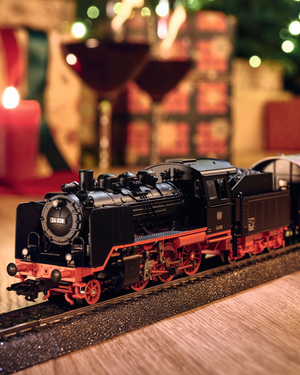The T16.1 is the first steam locomotive from ESU. The highly detailed model is largely made of metal and has numerous separately mounted detail parts. Of course, we detail all the finer differences according to the prototype. The finely finished wheels with their thin spokes are an eye-catcher in themselves. The model is a locomotive with worn wheel rims; this allowed us to achieve a prototypical distance between the axles. This provides sufficient space for the wheel flanges, which guarantees safe running, both with two- and three-rail systems. In order to minimize any dimensional deviations of the chassis, we guarantee excellent performance and driving characteristics at a radius of 420 mm and larger. Since these locomotives were used both in local freight traffic and for shunting work, the models are equipped with a digital coupling in the NEM shaft at both ends. Matching loop and hook couplings with a non-magnetic loop are included with the model. Of course, the synchronized smoke development of the exhaust gases is controlled by the axle sensor or by the internal electronics of the LokSound decoder. Of course, we listened carefully to the prototype in order to imitate the sound as closely as possible. For example, you can acoustically simulate the Riggenbach counter-pressure brake on a descent by activating it with a function button. The sounds of the various air and supply pumps varied. During shunting, the lanterns at the bottom right are switched on, as was usual with the prototype. The third headlight can be switched separately in order to display the signal Zg7, which indicates a special train in the opposite direction. For the first time, the lanterns are installed in series production as individual components (with the prototype still serving as an example). Every time the stoker shovels coal (acoustically, of course), the firebox glows softly.
| Model |
The large parts of the housing and chassis are made of metal |
|
Individually mounted detail parts made of brass or plastic |
|
Freestanding handles and lanterns |
|
Spring-loaded buffers |
|
Automatic coupling in standardized shaft according to NEM 362 |
|
Coreless motor with flywheel |
|
Five axles driven via coupling rods |
|
Two anti-slip tires |
|
Universal electronics for use on both DC and AC layouts |
|
Cab lighting, suitable lighting in shunting operation, illuminated firebox with warm white LEDs |
|
Controlled by ESU LokSound 5 decoder with high-quality loudspeaker |
|
“PowerPack” storage capacitor for uninterrupted power supply |
|
Load-dependent, fan-based and shaft-driven smoke generator with temperature control |
|
Automatic shunting couplings
|
|
Length over buffers 145.5 mm |
|
Minimum radius 420 mm
|
About the locomotive
The class 94.5-17 is one of the longest-standing and most successful Prussian locomotive designs. Its development even goes back to 1906, when the Royal Railway Directorate (KED - Königliche Eisenbahn-Direktion ) in Erfurt submitted its application to the Prussian Central Authority for the development of a D-coupled (five powered axles) steam locomotive for the steep gradients on the lines in Thuringia. The design of the T16 was strongly influenced by the well-known locomotive designer Robert Garbe and production began in 1905. A total of 343 units were built. With the reinforced T16 (later known as the T16.1) genuine universal locomotives were built between 1913 and 1924, which were at home everywhere in Prussia, in Alsace and Lorraine and from 1920 in all other parts of Germany. During the long construction period, several changes were made to the design. From 1921, the T16.1 had a feed dome, which meant that the recuperator had to be moved from the top of the boiler to the side next to the front sandbox. With the installation of the coupling for the steam heating systems from 1924, the T16.1 (later classified as BR 94.5) was also used for passenger transport. This locomotive became even more versatile with the increase in the permitted maximum speed to 60 km/h, after many parts had been standardized from 1927. With its axle load of 17 tons, the BR 94 was also suitable for branch lines with somewhat weaker road surfaces. In addition, thanks to the installation of the Riggenbach counter-pressure brake, it replaced the more modern but heavier BR T20 on the steep gradients in Thuringia. The prototypes of the ESU models BR 094 652 and 94 1292 became legendary. In the 1970s, they were both among the last locomotives of the class 94 in service with the DB and DR. Until 2005, the class 94 1292 proved its strength as a museum locomotive of the DB on the Rennsteig line and occasionally also on steep sections in the Eifel.


















